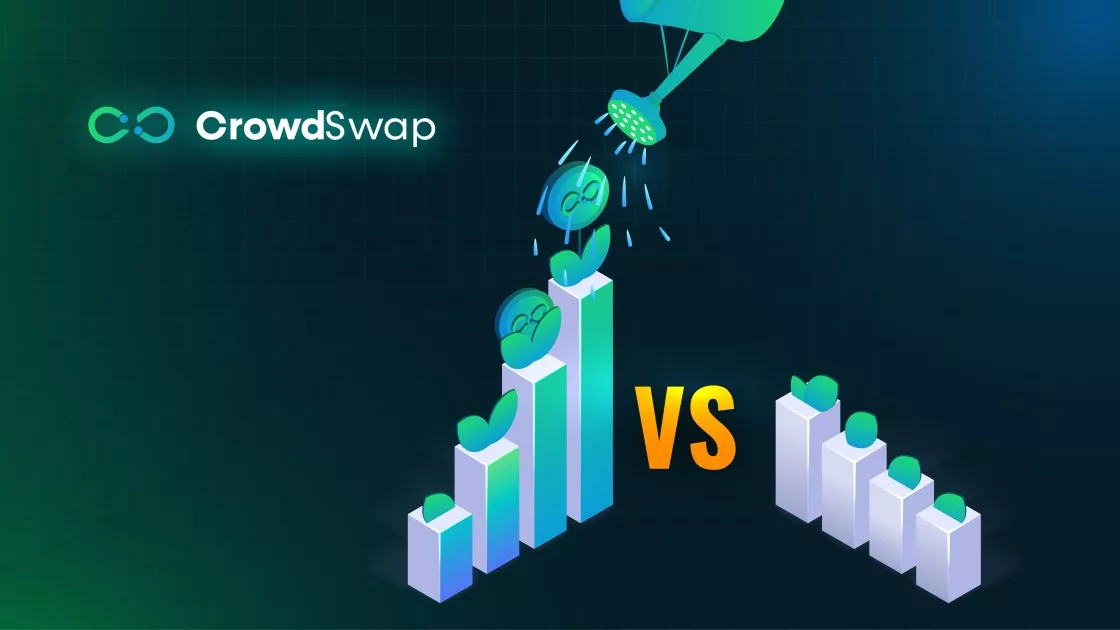In the ever-evolving decentralized finance (DeFi) landscape, staying informed is critical to maximizing your crypto investments. One concept that often confuses even seasoned traders is the difference between APY (Annual Percentage Yield) and APR (Annual Percentage Rate).
In crypto, APR stands for ‘Annual Percentage Rate’ and calculates the interest you earn annually by considering the compound interest. In contrast, On the other hand, APY stands for ‘Annual Percentage Yield’ and indicates the amount of interest you earn for your investment while considering compound interest. To better understand these concepts, let’s see what each means and what makes them different.
This comprehensive guide will delve deep into these critical metrics and help you make decisions in the DeFi space.
Read about: What is DeFi? All you need to know about decentralized finance – CrowdSwap
What is APY?
APY, or Annual Percentage Yield, is a critical finance metric, exceptionally decentralized finance (DeFi). It represents the potential return on an investment over a year when compounded interest is considered. In simple terms, APY reflects the interest you earn not only on your initial investment but also on the interest you’ve already made.
Why Does APY Matter?
APY is a crucial concept for DeFi participants because it helps maximize gains. Here’s a more detailed explanation:
Imagine you’ve invested money in a DeFi liquidity pool or a yield-farming project. If you focus solely on the APR (Annual Percentage Rate), which doesn’t consider compounding, you might underestimate your actual earnings potential.
APY factors in the compounding effect, which means that as you earn interest, it gets added to your principal, and future interest calculations are based on this increased amount. This compounding can significantly boost your overall returns over time.
Simply put, APY provides a more accurate representation of the growth of your investment since it considers the reinvestment of your earnings.
How to Calculate APY
To calculate APY, you can use the following formula:
APY = (1 + (r/n))^n – 1,
Where:
r is the nominal interest rate (expressed as a decimal).
n is the number of compounding periods per year.
This formula allows you to determine your potential APY based on the interest rate and how frequently it compounds.
Read more about: What is yield farming? How does it work? – CrowdSwap
Understanding APR (Annual Percentage Rate)
What is APR?
APR, or Annual Percentage Rate, is a widely used metric in traditional finance and is now making its way into the DeFi space. It represents the simple interest rate you’ll earn on an investment over a year without considering compounding. In essence, APR provides a straightforward calculation of the return you’ll receive without factoring in the reinvestment of interest earnings.
Why Does APR Matter?
APR is important because it gives you a clear understanding of the primary return on your investment without the complexity of compounding.
Here’s how it works:
Let’s say you’re considering two DeFi projects with different APRs. You can compare these rates to determine which offers a higher potential return for the same.
While APR may seem less attractive than APY due to its simplicity, it’s still a valuable metric for assessing straightforward investment returns. It benefits individuals who prefer a more detailed approach to their financial calculations.
How to Calculate APR
Calculating APR is relatively straightforward. You can use the following formula:
APR = (r/n) * n,
Where
r is the nominal interest rate (expressed as a decimal).
n is the number of compounding periods per year.
This formula yields the annual percentage rate without taking compounding into account.
In summary, APY and APR are essential metrics in DeFi and finance. While APY considers compounding, providing a more accurate representation of potential returns, APR offers a straightforward annual interest calculation without factoring in compounding. Both metrics have their place in assessing and comparing investment opportunities, and understanding them is vital for making informed financial decisions in the rapidly evolving world of cryptocurrency and decentralized finance.
APY vs APR
The main difference between APY and APR is that APY shows the interest you earn for your investment. At the same time, APR calculates the amount of interest you gain without compound interest. Therefore, you must remember that although they seem the same, they are used for different situations. Another essential factor differentiating these two is that the APR is typically other in each year of the loan, while APY stays the same in all years of the investment.
One thing that DeFi investors need to take into consideration is that in decentralized finance, market conditions are a factor that can make APY fluctuate over time. This is not because of APY’s nature; as said earlier, APY tends to stay the same. Nevertheless, this fluctuation in the APY rate is because of the nature of the cryptocurrency market. You can read more about APY in DeFi from this link.
Understanding the Differences
1. Treatment of Compounding
• APY (Annual Percentage Yield):
APY takes compounding into account. It considers the interest you earn on your initial investment and the interest you’ve already made, providing a more comprehensive view of your potential returns. APY reflects the power of reinvesting your earnings to maximize gains over time.
• APR (Annual Percentage Rate):
APR does not consider compounding. It represents the simple interest rate you’ll earn over a year without factoring in the reinvestment of your interest earnings. APR offers a straightforward, non-compounded view of potential returns.
2. APY and APR’s main difference
• APY:
APY provides a more accurate representation of your investment’s growth because it includes the compounding effect. As you earn interest, it adds to your principal, leading to higher returns. APY reflects the actual returns you can expect when reinvesting.
• APR:
APR gives you a basic, non-compounded view of your returns. It provides a simple percentage representing your interest earnings over a year without considering the reinvestment of those earnings. APR offers a clear, linear view of potential returns.
3. Use Cases
• APY:
APY is valuable for investors who seek to maximize their earnings over time. It’s commonly used in DeFi platforms and yield farming projects where compounding can significantly boost returns. APY is suitable for those comfortable with managing the complexities of compounding.
• APR:
APR is useful for individuals who prefer a straightforward approach to assessing returns. It’s commonly used in traditional finance but is also becoming relevant in DeFi. APR suits those who want a clear, simple understanding of potential interest earnings.
4.Risk Assessment
• APY:
Understanding APY is crucial for accurately assessing the risk associated with DeFi projects. It accounts for the compounding effect, helping investors gauge the sustainability of high-yield opportunities.
• APR:
APR provides a straightforward view of returns but may not capture the full risk associated with DeFi projects. Investors should use APR alongside other risk assessment methods when evaluating investments.
5. Decision-Making
• APY:
When comparing DeFi projects or investments, APY allows you to make more informed decisions by factoring in compounding. It helps you select opportunities that align with your financial goals, risk tolerance, and investment horizon.
• APR:
APR provides a baseline for assessing investment opportunities but may not account for the full potential of compounding. Investors should consider both APR and APY to make well-rounded decisions.
Read more about How to Invest in Cryptocurrency? – CrowdSwap
Real-world examples of APY vs APR
Let’s take a real-world example to illustrate the impact of compounding on your DeFi investments:
You invest $1,000 in a DeFi liquidity pool with an APR of 20%, compounded daily (365 compounding periods per year). Using the formulas, we can calculate both APY and APR:
APY = (1 + (0.20/365))^365 – 1
APR = (0.20/365) * 365.
After one year, your actual earnings with APY would be approximately $221.39, while your earnings with APR would be exactly $200.
This example demonstrates how considering APY can lead to higher returns due to the compounding effect.
Suggestion to read: How to Invest in DeFi – CrowdSwap
Trade Effortlessly
Ready to dive deeper? Our crypto exchange is simple and user-friendly, making trading a breeze
Conclusion
In the world of DeFi, understanding the APY vs APR can make a difference in your crypto journey. Both APY and APR calculate the yearly interest of your funds. But APY is used for how much you earn on a DeFi platform in a compound matter, and APR indicates the amount of interest you receive without compound interest. By recognizing the importance of compounding and making informed decisions based on both metrics, you can maximize your gains while managing risk effectively.













